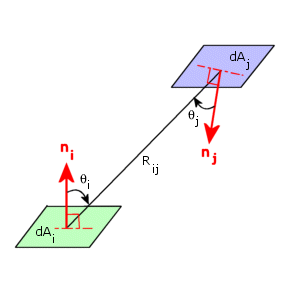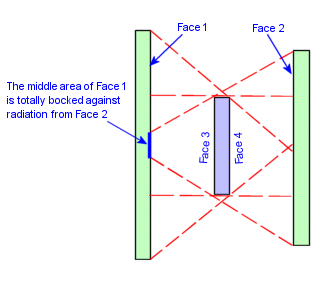View factors, also known as shape or configuration factors, play a direct role in heat transfer due to radiation. The view factor F
ij between two small areas A
i and A
j is defined as the fraction of the radiation leaving area A
i that is intercepted by area A
j. In other words, F
ij represents how well A
i sees A
j. The view factor F
ij depends on the orientation of the small areas A
i and A
j and the distance between them.

For the two infinitesimal surfaces
dAi and
dAj , the view factor
dFij is given by:

where Θ
i and Θ
j are the angles between the unit normals to the areas and the line
Rij connecting the two areas. If the two areas are finite, then the view factor is given by:

From the above equation, the following reciprocity relation always holds:

While many heat transfer books provide view factors for simple-shaped areas, calculating view factors for real life problems requires major effort even for fast computers. When requested to calculate view factors for the radiation between face A and face B, the software thinks of each face as composed of small areas (surfaces) defined by element faces. It then calculates a view factor for each element face relative to every other element face in the set. View factors between element faces on the same geometrical face are included in these calculations.

A concave face with a reasonably fine mesh can radiate to itself. Planar and convex faces do not radiate to themselves. Such effects are automatically considered.
Blocking
The radiation between two element faces can be blocked by a third element face. In that case, the view factor becomes 0. The software automatically considers blocking among all specified faces as illustrated in the figure. For proper blocking considerations, you must select faces participating in the radiation. In the example below, faces 3 and 4 partially block the radiation between faces 1 and 2. Incorrect results are obtained if you select faces 1, 2, and 3 only.
